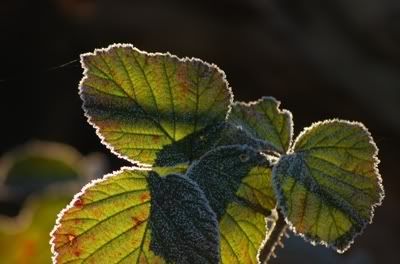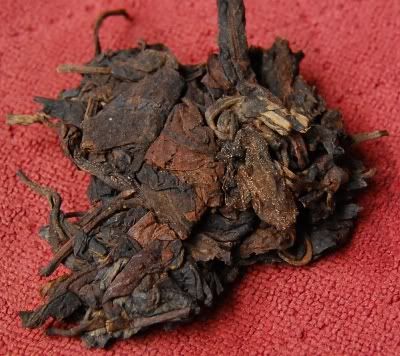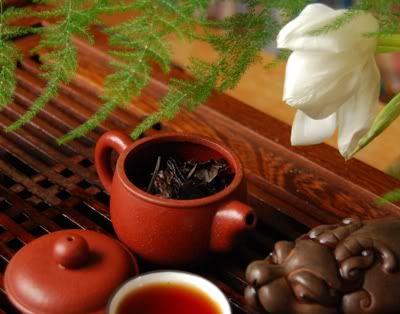London: cold, unwelcoming, distant. Much the same goes for the average Londoner on the street, too.
Fragile life.
Fragile life.

In a city of such size, maybe it's inevitable that individual humanity goes by the wayside. Distant eyes, distant faces, hunched shoulders. Big clocks ticking on big buildings. Bus drivers openly cursing. People soup.
I'm in the capital for a two-hour examination unrelated to my studies, and am looking forward to getting back to the peace of home. An oasis in the middle of town, TeaSmith is one of the good points of the city, along with all its forgotten churches. I get plenty of both before and after my exam.
The cafe doesn't change much, which is a good thing, as they're onto a winner. Warm conversation, good music, decent tea. Of interest on the current menu is a buttery baozhong. They were even kind enough to dig out a 2005 Xiaguan "Wild Big-Tree" cake from a cupboard.
Back at home, it's time to dig into some a 1990s Song Pin cake (originally from Dragon Tea-House), kindly provided by the ever-generous CB...

Yellow specks (pictured above)! Given the advanced state of decay of most of the cheese that we eat, a little mould won't stop me. Two rinses of boiling water, and we're ready.

There are plenty of "yellow leaves" evident in this cake, those thin and brittle examples that tend not to impart much flavour, but plenty of bitterness. These are mixed with a good proportion of small, furry tips.
I like shicang tea, so the plentiful shicang [wet storehouse] aroma is fine by me. It also explains the mould..

As you can see, the brew is an encouragingly deep red. The soup is not too potent; despite filling my small pot, and infusing for long periods, the result is not overbrewed. This could be down to the high concentration of small tip-leaves - always gentle.
Maltiness and "dustiness" are present in both aroma and flavour, while the texture is also "dusty", though there is no sediment. Some ku remains, but it is well on the way to becoming mature pu'er. If you like that familiar and enjoyable "numbness" in the mouth, you'll enjoy this tea.
The whole is very gentle. I look for larger leaves in a good cake, in order to provide a solid basis, but this is mostly tips and "yellow leaves".
This is easily worth the £40 asking-price. I have been drinking a lot of 2007 Xizihao recently, which is often much more expensive and less interesting.
Many thanks, CB, for a great tea.

9 comments:
Following my comments on your photos last night, I do adore the photo on the bottom - nice frame by the green leaves and white tulip; well-balanced compostion too.
I think I got a bit lucky there, the light was kind. :)
Glad you're finding this one enjoyable. Regarding the yellow spots: I'm not at all sure that these indicate mold; although I first thought so. Check out the "Other View" description of a black tea brick sold by Jing:
http://www.jingteashop.com/pd_black_tea_gz.cfm
He writes: "The Jin Hua isn't yellow mold, it is a type of crystal that appears on black tea, also cooked pu erh, from time to time but only if the storage is clean and dry."
I've noticed very similar spots (like what you photographed) on sheng as well, though they tend towards white instead of yellow, and their presence doesn't seem to correlate with the wet-stored taste, which strikes me as: wet fall leaves, lack of complexity, and spiciness in the "good" shicang case, and composted leaves, mustiness, and roughness in the worse cases.
I tend to think this particular tea was wet stored for a time (because of the dark, masculine, fall leaves flavors mentioned in my tasting notes), though I didn't detect any mustiness, and am really on the fence WRT this point. One would think that visible mold could be tasted. I'm tempted to send a sample of tea with the spots to my pathologist sister and see if she can tell, using the microscope, whether we're looking at crystals or mold.
Interesting, my feng quing shu has some of that yellow stuff. I drink it but rince the lot well.
Good to know it's not cheese!
OK. After remembering that we have, in the electronics lab, microscopes most often used for checking wirebonding connections, I find myself at work on a Saturday, bringing a sample of a '99 MH 7542 which I happen to be drinking; it is covered with those telltale white spots, though the tea doesn't have any taste of wet storage whatsoever; what tale will these little spots tell? Under the lense, it becomes immediately obvious; the glinting light reveals a forest of crystals, not mold at all. In fact, the whole surface is glazed and sparkling, with the build-ups being the white spots visible to the naked eye. I find myself wishing this scope was fitted with a camera, particularly because of how gnarly the tea looks up this close, with each bud-hair looking like 3 days of beard growth. Will this hold true for the Song pin? I scurry back to the tea box and break off a few leaves that show the white spots. Oh my, yes. No mold; find a microscope and see for yourself. Darn, I wish this one had a camera.
Thank you Speak for the great comments! I guess now the big question is-What the heck causes these crystals to form in the first place?
Hop
Dear all,
Thanks for the great information, and for the detailed analysis, Carla! I don't think I've had the pleasure of coming across the infamous "Golden Flowers" before, so it's quite an education.
It's good tea, nonetheless! I brought some to Montana, in fact, and am looking forward to revisiting it.
Toodlepip all,
Hobbes
LOL, that tea will have travelled around the world several times before it gets consumed! Save a leaf or two with the spots for later analysis under a microscope - you've got to have one kicking around the University somewhere; just a low-power dissecting scope should do. It's really amazing what you'll see; well worth the effort.
A great idea, Carla, were it not for the fact that the Song Pin was the very tea that we just had (and finished!) this afternoon. Thanks again for a real treat of a tea - it's perfect for soothing an aching body come late afternoon.
Toodlepip,
Hobbes
Post a Comment